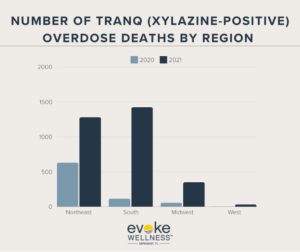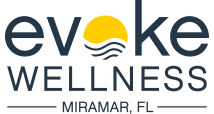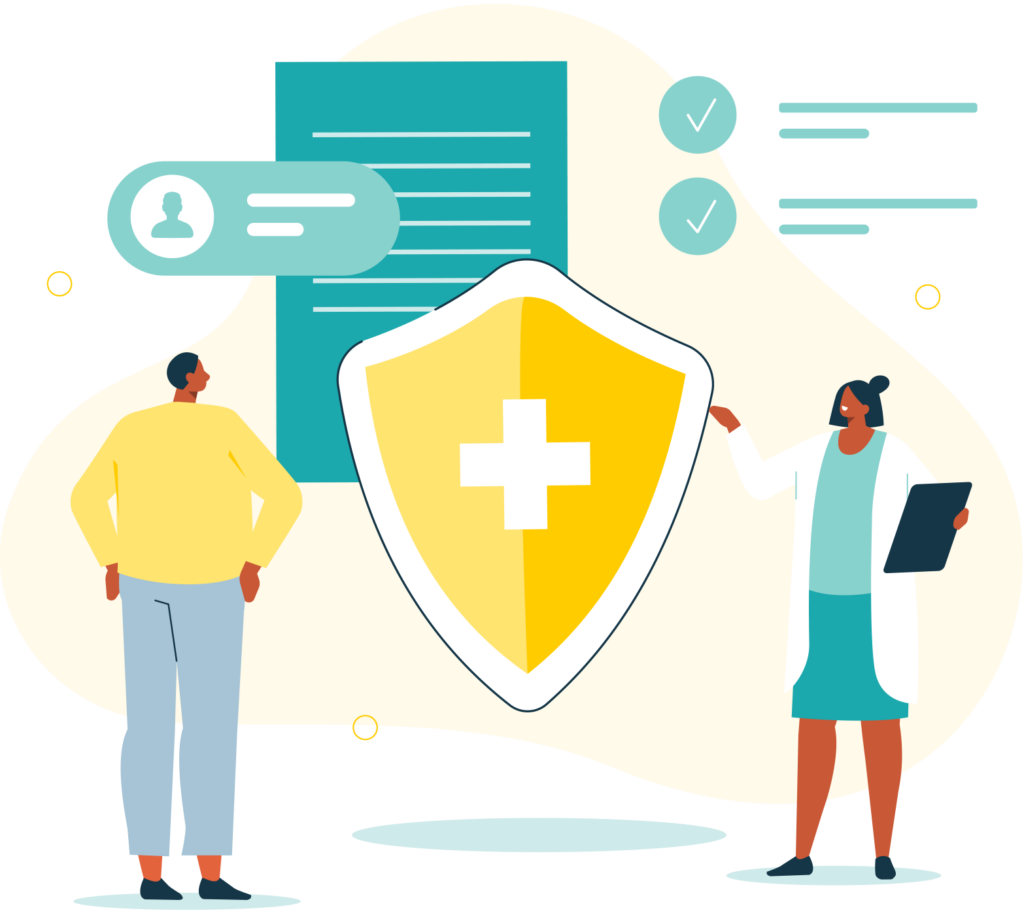You’ve heard about the drug Tranq. Now you want to know what it is, why people use it, and how to help someone struggling with Tranq addiction. This article will explain what Tranq is, how it affects the brain, and signs of Tranq addiction. We’ll also cover treatment options like rehab programs, therapy, and relapse prevention. You’ll learn how to support your loved one on the road to recovery. Equipped with knowledge and resources, you can take the first steps in overcoming Tranq addiction. This article provides facts, treatment options, and hope.
Call Evoke Wellness at Miramar today (833) 819-6066 or reach out online.
The Tranq Addiction Crisis
Tranq, also known as xylazine, is a powerful animal sedative that has emerged as a dangerous addition to the illicit drug supply. This non-opioid substance is causing a harrowing new chapter in the overdose crisis, with devastating effects on human health.
A Deadly Combination
When combined with fentanyl or other opioids, tranq can lead to severe skin ulcers, soft tissue infections, and even limb amputations. Its numbing effects mask the symptoms of an overdose, making it harder to recognize and respond in time.
Finding Help
If you or a loved one is struggling with tranq addiction, know that recovery is possible. Evoke Wellness offers comprehensive treatment programs tailored to each individual’s needs, including:
- Medically supervised detox
- Inpatient treatment and outpatient rehab
- Dual diagnosis treatment for co-occurring disorders
- Relapse prevention strategies
- Individual and group therapy
With compassionate care and evidence-based approaches, we empower individuals to break free from addiction and reclaim their lives.
DEA Reports Widespread Threat of Fentanyl Mixed With Xylazine
As an individual seeking to understand addiction, it’s crucial to be aware of the evolving drug landscape. The Drug Enforcement Administration (DEA) has issued a warning about a particularly dangerous combination – fentanyl laced with xylazine, a powerful veterinary sedative.
A Deadly Mix
This potent blend poses a severe threat, as xylazine is not an opioid and cannot be reversed with naloxone, the standard treatment for opioid overdoses. This means that individuals who unknowingly consume this mixture are at an alarmingly high risk of respiratory depression and death.
Widespread Contamination
According to the DEA, this deadly cocktail has been identified in various drug supplies across the United States, including illicit fentanyl and other substances. Its presence underscores the importance of understanding the risks associated with substance abuse and seeking professional help when needed.
Seeking Support
If you or a loved one is struggling with addiction, know that there are resources available to help. Evoke Wellness at Miramar offers comprehensive addiction treatment programs tailored to individual needs, including:
- Substance use treatment program
- Dual Diagnosis Treatment
- Relapse Prevention Program
- Drug rehab program
- Individual therapy program
Remember, addiction is a treatable condition, and seeking support is a courageous step towards reclaiming your life.
What Is Tranq (Xylazine)?
A Deadly Drug Combination
Tranq, also known as xylazine, is a non-opioid veterinary sedative that has been increasingly found mixed into illicit drugs like heroin and fentanyl. This dangerous combination can lead to severe wounds, necrotic skin lesions, and even death.
Troubling Spread
Originally used as an animal tranquilizer, xylazine’s spread into the illegal drug supply has been steadily rising across the United States. The drug causes numbness, amnesia, and dangerous suppression of vital functions like breathing and heart rate.
High Risk of Overdose
When combined with opioids, tranq increases the already high risk of overdose. The sedative effects can dangerously depress respiration and blood oxygen levels. Prompt medical treatment is crucial for any suspected xylazine exposure or overdose.
Getting comprehensive, professional addiction treatment is essential for overcoming tranq and opioid dependence. Early intervention gives the best chance at lasting recovery.
How Is Tranq Used?
Recreational Use
Tranq, also known as “zombie drug,” is a powerful synthetic opioid analgesic. It is sometimes used recreationally for its potent, heroin-like effects. However, this illegal use can lead to:
- Respiratory depression
- Unconsciousness
- Overdose and death
Cutting Other Drugs
Tranq is also increasingly being used to cut or lace other illicit drugs like heroin, fentanyl, cocaine and methamphetamine. This makes these drugs even more unpredictable and dangerous.
Medical Use
Tranq has no approved medical uses in humans. However, it was originally developed as an animal tranquilizer – hence the name “tranq.” Any human use outside of a supervised medical setting is extremely risky.
The potency, unpredictability and potentially deadly effects of tranq make addressing its use and addiction a major public health priority. Professional substance abuse treatment is often required.
What Effect Does Tranq Have on Humans?
Severe Wound Infections
Tranq, also known as xylazine, is a powerful sedative and muscle relaxant. When used by humans, it can lead to severe necrotic skin ulcers that are difficult to treat and heal. These open wounds carry a high risk of serious infections like gangrene.
Overdose Risk
Tranq does not respond to naloxone, the standard overdose-reversal medication. This makes overdoses involving tranq more dangerous and life-threatening. Reports indicate a higher rate of overdose deaths when tranq is present.
Other Toxic Effects
Other effects include:
- Respiratory depression and breathing issues
- Dangerously low blood pressure and heart rate
- Severe sedation or unconsciousness
- Potential organ damage
Tranq produces effects similar to other opioids but is not an opioid itself. Its interaction with opioids increases the risk of negative side effects and overdose. Seeking professional addiction treatment is crucial for recovery.
How Do You Treat Tranq Overdoses?
Recognizing Overdose Symptoms
Tranq overdoses require immediate medical attention. Key signs include disorientation, drowsiness, shallow breathing, and loss of consciousness. Acting quickly is crucial.
Calling Emergency Services
If you suspect an overdose, call 911 immediately. Provide any known details about the substance(s) consumed. Follow dispatcher instructions carefully.
Overdose Response
While waiting for help:
- Try to keep the person awake and breathing
- Administer naloxone if available and trained
- Perform rescue breathing or CPR if needed
Treatment and Recovery
Surviving a tranq overdose often requires hospitalization. Further addiction treatment may include:
- Medication-assisted treatment to ease withdrawal
- Inpatient or outpatient rehabilitation programs
- Therapy to address underlying issues
- Peer support and counseling
With comprehensive care, recovering from tranq addiction is possible. Seeking prompt medical help during an overdose can save a life.

Tranq Addiction Treatment Programs
Comprehensive Treatment Plans
At our tranq addiction treatment center, we offer comprehensive plans tailored to each individual’s unique needs. Our evidence-based approach combines:
- Medically supervised detox
- Behavioral therapies
- Holistic healing practices
Our goal is long-term recovery.
Dual Diagnosis Treatment
Many with tranq addiction also struggle with co-occurring mental health disorders like depression or anxiety. Our dual diagnosis program addresses both substance abuse and mental illness simultaneously through:
- Psychiatric evaluations
- Integrated counseling
- Medication management
Relapse Prevention Strategies
Relapse is a real risk, but our program equips clients with vital skills to avoid triggers and maintain sobriety through:
- Cognitive behavioral therapy
- Mindfulness practices
- Ongoing alumni support
Personalized Therapy Plans
One-on-one counseling allows our therapists to dive deep into root causes. Tailored therapy plans may include:
- Trauma-informed care
- Family systems therapy
- Motivational interviewing
The goal is lasting behavioral change.
With compassionate, evidence-based care, our tranq addiction treatment helps individuals reclaim their lives. Recovery is possible.
Frequently Asked Questions About Tranq Addiction Treatment
What is Tranq Addiction?
- Tranq addiction refers to the compulsive use and dependence on tranquilizers like Xanax or Valium. These sedative drugs can be highly addictive, leading to physical and psychological dependence.
What Treatment Options are Available?
- Addiction treatment programs: Inpatient rehab, outpatient programs, support groups.
- Substance use treatment: Detox, medication-assisted treatment, behavioral therapies.
- Dual diagnosis treatment: For co-occurring mental health disorders.
- Relapse prevention: Aftercare planning, coping strategies, sober living.
How Long Does Treatment Take?
Treatment duration varies based on the severity of addiction and individual needs. Short-term programs last 30-90 days, while long-term care may extend 6 months to a year or more.
Will Insurance Cover Rehab?
Many insurance plans cover some or all of the costs for evidence-based addiction treatment. Check with your provider about coverage details and pre-approval requirements.
Conclusion
You now have a deeper understanding of the dangers of Tranq and the treatment options available to help a loved one recover. With knowledge comes power – you can educate yourself further, have compassion for their struggle, and take action to get them help. Recovery is a journey, but one that’s possible with the right treatment program. Support your loved one by exploring dual diagnosis treatment, relapse prevention, individual therapy, and other evidence-based options. Their future depends on it. You can make a difference.
Begin Your Journey with Evoke Wellness at Miramar
If you or a loved one is considering treatment, Evoke Wellness at Miramar invites you to contact us. Our compassionate team is ready to answer your questions, discuss your needs, and help you take the first steps toward recovery. In Miramar, you’ll find more than just a treatment program – you’ll discover a community dedicated to your wellness and success. Together, let’s embrace the journey to recovery and the promise of a new beginning. Call us at (833) 819-6066 today or reach out online.


